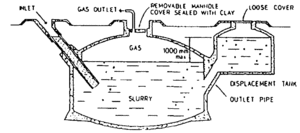No edit summary |
No edit summary |
||
| Line 1: | Line 1: | ||
'''Fixed dome digesters''' are one of the most well-known biogas generators in the world. These simple, typically underground generators originated in China circa. 1936<ref> | '''Fixed dome digesters''' are one of the most well-known biogas generators in the world. These simple, typically underground generators originated in China circa. 1936<ref> | ||
http://www.biogassa.co.za/digesters.html | http://www.biogassa.co.za/digesters.html | ||
</ref>. Due to their relative simplicity and use of readily available materials both as fuel and in construction, fixed dome digesters have become increasingly popular throughout the world. The typical structure of a fixed dome digester consists of an inlet trough, a lower fermenting reservoir with a rigid, immovable collection dome capping it, and some type of overflow relief. Several different types of fixed dome digesters exist, but by far the most popular is the Chinese design, which is typically built of gas-sealed brick and mortar or cement. | </ref>. [[Image:Digester.GIF|thumb|right|A fixed-dome type biodigester. [http://www.fao.org/docrep/T0541E/T0541E0E.GIF]]]Due to their relative simplicity and use of readily available materials both as fuel and in construction, fixed dome digesters have become increasingly popular throughout the world. The typical structure of a fixed dome digester consists of an inlet trough, a lower fermenting reservoir with a rigid, immovable collection dome capping it, and some type of overflow relief. Several different types of fixed dome digesters exist, but by far the most popular is the Chinese design, which is typically built of gas-sealed brick and mortar or cement. | ||
The simple design of a fixed-dome digester and its lack of moving parts means that if constructed well, the structure will last for many years. However, the design is by nature inaccessible due to its (usually) underground construction, and its lack of moving parts means that access to the interior of the digester (say for cleaning and maintenance purposes) is extremely difficult. Since the methane gas inside the collection chamber is being pushed out only by the pressure of other methane, the gas pressure coming out of the collector is subject to large fluctuations, making it unsuitable to use for cooking, or other applications requiring a steady stream of gas flow, without an additional regulating device<ref>http://fastonline.org/CD3WD_40/BIOGSHTM/EN/APPLDEV/DESIGN/DIGESTYPES.HTML</ref>. | The simple design of a fixed-dome digester and its lack of moving parts means that if constructed well, the structure will last for many years. However, the design is by nature inaccessible due to its (usually) underground construction, and its lack of moving parts means that access to the interior of the digester (say for cleaning and maintenance purposes) is extremely difficult. Since the methane gas inside the collection chamber is being pushed out only by the pressure of other methane, the gas pressure coming out of the collector is subject to large fluctuations, making it unsuitable to use for cooking, or other applications requiring a steady stream of gas flow, without an additional regulating device<ref>http://fastonline.org/CD3WD_40/BIOGSHTM/EN/APPLDEV/DESIGN/DIGESTYPES.HTML</ref>. | ||
Revision as of 20:53, 30 November 2012
Fixed dome digesters are one of the most well-known biogas generators in the world. These simple, typically underground generators originated in China circa. 1936[1].

Due to their relative simplicity and use of readily available materials both as fuel and in construction, fixed dome digesters have become increasingly popular throughout the world. The typical structure of a fixed dome digester consists of an inlet trough, a lower fermenting reservoir with a rigid, immovable collection dome capping it, and some type of overflow relief. Several different types of fixed dome digesters exist, but by far the most popular is the Chinese design, which is typically built of gas-sealed brick and mortar or cement.
The simple design of a fixed-dome digester and its lack of moving parts means that if constructed well, the structure will last for many years. However, the design is by nature inaccessible due to its (usually) underground construction, and its lack of moving parts means that access to the interior of the digester (say for cleaning and maintenance purposes) is extremely difficult. Since the methane gas inside the collection chamber is being pushed out only by the pressure of other methane, the gas pressure coming out of the collector is subject to large fluctuations, making it unsuitable to use for cooking, or other applications requiring a steady stream of gas flow, without an additional regulating device[2].
Pros
- Sturdy and possible to build from cheap, inexpensive materials
- Unobtrusive- typically buried.
- Well insulated. The underground design combined with typically porous building materials allows the biodigester to remain at a productive temperature for longer.
Cons
- Skilled bricklayers needed to construct a usable gas collection dome
- Entire structure must be airtight in order to keep collected methane from escaping
- Typically underground construction limits accessibility and repair
- If cold, insulated design increases time to produce methane each day
- Gas outlet subject to large pressure fluctuations